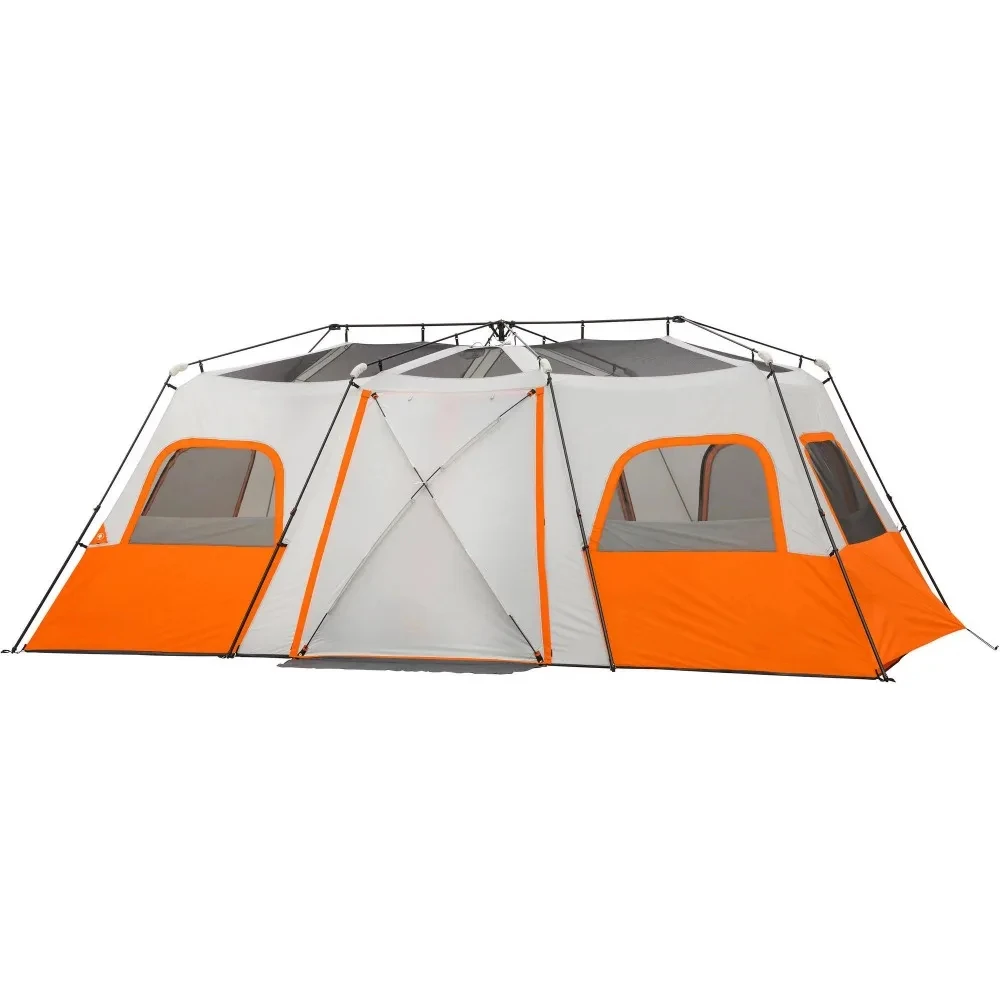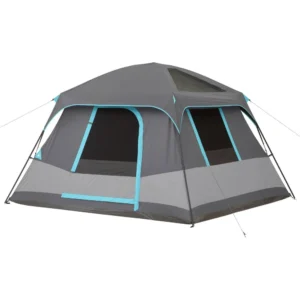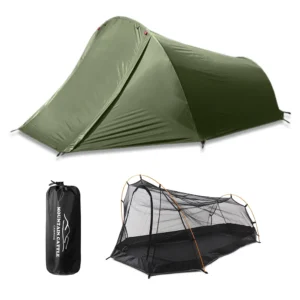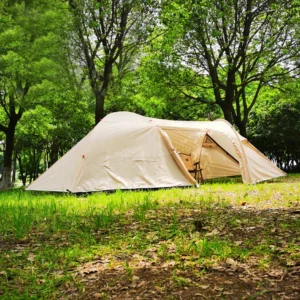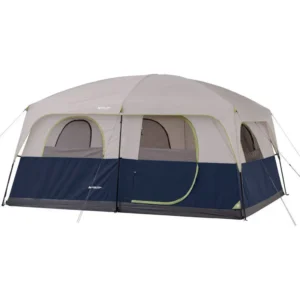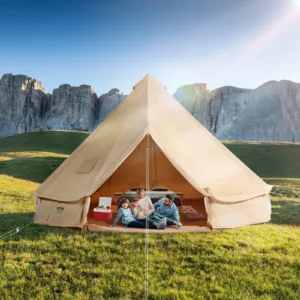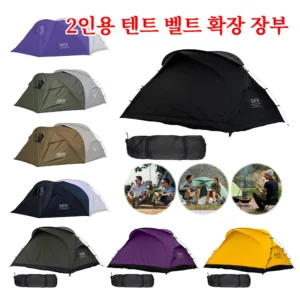Why Choose a Two-Compartment Tent: Enhancing Your Camping Experience
Two-compartment tents represent a game-changing solution for campers seeking both togetherness and privacy during outdoor adventures. These specialized shelters feature internal dividers that create separate spaces within a single tent structure, offering a perfect balance between shared camping experiences and personal space.
The benefits of choosing a tent with divided spaces go far beyond simple convenience:
- Enhanced privacy for changing clothes, sleeping, or simply having a moment of solitude
- Better organization with dedicated spaces for sleeping and gear storage
- Reduced clutter by separating living and sleeping areas
- Temperature management with the ability to close off sections as needed
- Noise reduction between sleeping areas for better rest
These versatile shelters are particularly valuable for families with children, groups of friends with different sleep schedules, or couples who want separate areas for sleeping and gear storage. Understanding different shelter options for two campers helps you make better decisions when selecting your next outdoor home.
Throughout this guide, we’ll explore the top two-compartment tent models available today, all field-tested by our experienced team at Explore Elements. We’ll examine their unique features, help you understand critical design elements, and provide practical advice for selecting the perfect divided tent for your specific needs.
Before diving into specific models, it’s worth considering that knowing what size tent is good for 2 people provides valuable context even when looking at larger multi-compartment options. The principles of space allocation remain important regardless of tent size.
Top-Rated Two-Compartment Tents of the Year
Best Overall Two-Compartment Tent: Perfect Balance of Features
After extensive testing across various terrains and weather conditions, one model stands out as the ultimate combination of quality, functionality, and thoughtful design. This premium two-compartment tent offers exceptional performance for campers seeking the ideal balance of shared and private spaces.
The standout feature is its divider system, which uses heavy-duty waterproof nylon with silent zipper mechanisms. Unlike flimsier dividers found in budget models, this creates true room-like separation while maintaining structural integrity. The divider attaches securely to reinforced seams along the ceiling and walls, eliminating light bleed between compartments.
Key Specifications:
* Capacity: 4-6 people comfortably
* Dimensions: 10’ × 8.5’ (3m × 2.6m) with 6.5’ (2m) center height
* Weight: 18.5 lbs (8.4 kg)
* Pack Size: 25” × 9” (63.5cm × 22.9cm)
Setup requires approximately 10-12 minutes with two people, featuring color-coded poles and intuitive sleeve systems that eliminate guesswork. The reinforced aluminum frame withstands winds up to 40 mph while maintaining shape and stability.
What truly distinguishes this model is its thoughtful balance of features. Each compartment has its own entrance and vestibule, allowing independent access without disturbing others. Interior mesh pockets are positioned strategically in both rooms, and the gear loft spans the entire ceiling for maximum storage.
Many two-room camping tent options sacrifice either durability or packability, but this model achieves excellence in both areas, making it our top recommendation for most campers seeking divided spaces.
Best Family-Friendly Two-Compartment Tent: Spacious and Functional
For families seeking the perfect balance of togetherness and privacy, our top family-friendly pick offers thoughtful features specifically designed for parents camping with children.
The standout element is the intelligently positioned room divider that creates a clear parent/child separation while allowing easy monitoring. Unlike standard dividers, this one features a small zippered window that parents can use to check on sleeping children without entering their space.
Family-specific features that earned this tent top marks include:
- Extra-large storage pockets at child-accessible heights
- Blackout coating in the children’s compartment for better daytime napping
- Glow-in-the-dark zipper pulls and guy line attachments
- Multiple entrance points to avoid climbing over sleeping family members
- Reinforced floor material that withstands increased foot traffic and rough play
With a generous 85 square feet (7.9 square meters) of floor space and a center height of 6.5 feet (2m), this tent provides ample room for parents, children, and essential gear. The nearly vertical walls maximize usable space, unlike dome tents with sharply sloping sides.
Setup remains manageable even with “helpful” little hands, taking most families about 15 minutes after their first practice run. Color-coded poles and simple instructions make the process straightforward even for camping novices.
Understanding the various uses of two-room tents for group camping helps families maximize their enjoyment of these versatile shelters. The thoughtful design elements in this model specifically address the challenges families face when sharing confined spaces in the outdoors.
Best Budget-Friendly Two-Compartment Tent: Quality Without Breaking the Bank
Not everyone can invest in premium camping equipment, but that shouldn’t mean sacrificing the privacy and organization benefits of a two-compartment tent. Our budget-friendly pick delivers essential divided-space functionality without the premium price tag.
This model intelligently preserves quality where it matters most while making reasonable compromises to reduce cost. The manufacturer maintains durable waterproof materials for the rainfly and floor (the most critical water protection points) while using slightly lighter materials for the main tent body. Similarly, the poles are fiberglass rather than aluminum—heavier but significantly less expensive.
The divider itself uses lightweight polyester rather than heavy-duty nylon, providing visual privacy while keeping weight and cost down. Though not completely soundproof, it effectively creates separate spaces for sleeping and storage.
Key value considerations include:
- Priced 30-40% lower than premium alternatives
- 2-year warranty (compared to 3-5 years for higher-end models)
- Weight of 15.5 lbs (7 kg)—comparable to many single-compartment tents
- Simplified ventilation system that still prevents major condensation issues
- Basic but functional internal storage options
This tent is ideal for weekend campers, those new to outdoor adventures, or anyone who camps occasionally rather than frequently. The design prioritizes straightforward functionality and reasonable durability over premium features.
For those just beginning their outdoor adventures, mastering two-person lightweight tent setup skills transfers well to these larger models, making the transition to family camping smoother.
Best Weather-Resistant Two-Compartment Tent: Protection in All Conditions
For campers who refuse to let challenging weather dictate their adventures, our top weather-resistant pick provides exceptional protection while maintaining the benefits of divided interior spaces.
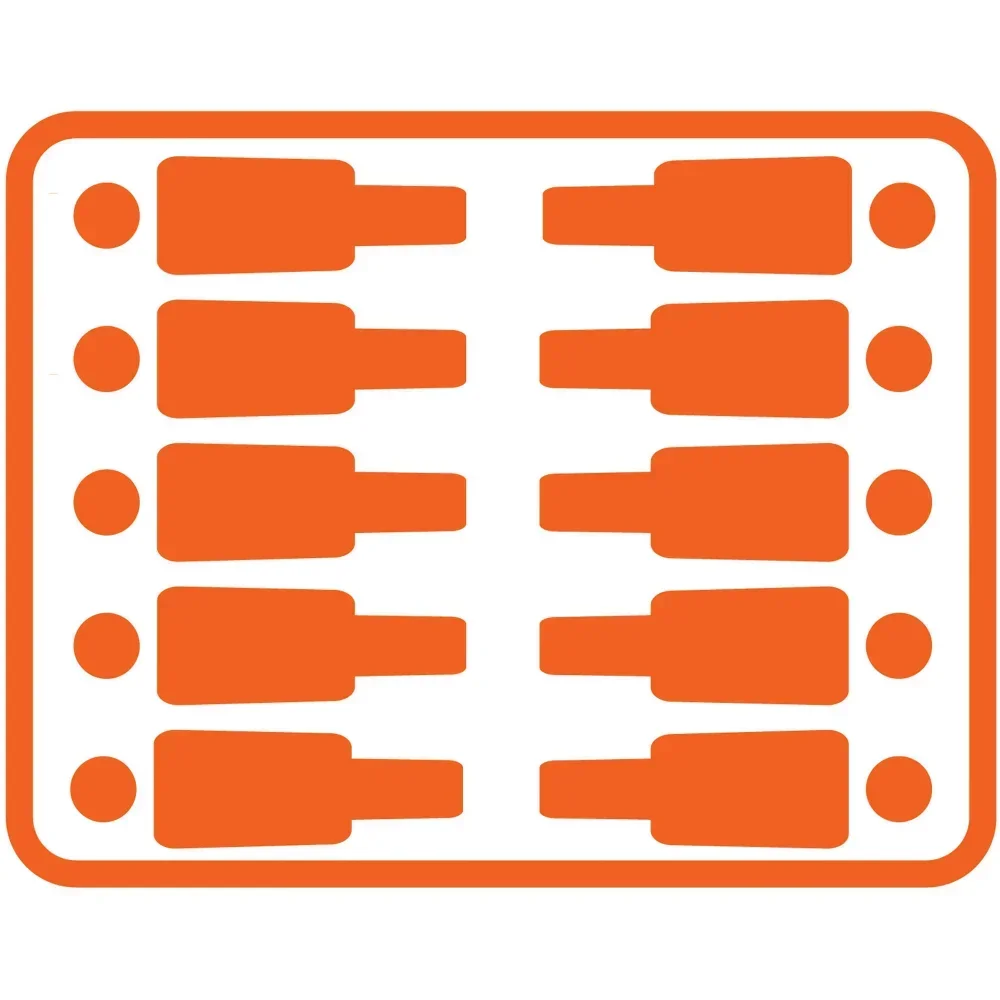
Built to withstand everything from desert heat to mountain storms, this robust shelter features a fully-seam-sealed construction with reinforced stress points throughout the design. The rainfly extends nearly to the ground, creating protective vestibules outside each entrance while channeling water away from the doors.
Weather protection specifications:
* 3000mm hydrostatic head waterproof rating (industry standard is 1200-1500mm)
* Bathtub-style floor extending 5” (12.7cm) up the sides
* Reinforced aluminum poles with wind stability rating of 45+ mph
* Strategic guy-out points with reflective, adjustable tensioners
* Four-season capability with snow-load supporting frame design
Despite this rugged construction, the interior maintains comfort with a full-height center divider that creates genuine separation between spaces. Each compartment features dedicated ventilation controls, allowing occupants to regulate airflow based on their preferences without compromising the adjacent space.
The tent’s ventilation system deserves special mention—mesh panels positioned strategically throughout the structure create excellent cross-ventilation while remaining protected by the rainfly. This prevents the condensation issues that often plague weatherproof tents, especially when occupied by multiple people.
For those seeking serious protection from the elements, exploring our collection of waterproof camping tent options provides additional alternatives with strong weather resistance capabilities combined with multi-room designs.
Most Versatile Two-Compartment Tent: Adaptable for Various Needs
The most adaptable two-compartment tent in our lineup transforms to meet dramatically different camping scenarios through innovative design elements and thoughtful configuration options.
Unlike tents with fixed dividers, this model features a completely removable and repositionable divider system. The main divider can be installed in three different positions, creating either equal compartments or asymmetric spaces based on your needs. Additionally, the divider itself can be configured as either a solid privacy wall or a mesh panel for improved airflow while maintaining visual separation.
This tent’s versatility extends beyond its interior arrangements:
- Multiple door configurations with removable/rollable panels
- Adaptable ventilation system with closable/openable mesh sections
- Convertible vestibule that transforms from gear storage to covered outdoor sitting area
- Modular rainfly that can be deployed partially or fully based on weather conditions
- Removable floor in the “porch” section for easier cleaning
The adaptability makes this model perfect for campers whose group composition changes between trips. It works equally well for couples wanting separate sleeping and living spaces, parents with children requiring privacy, or friends sharing accommodations with defined personal areas.
At 17 lbs (7.7 kg), it strikes a reasonable balance between durability and portability, packing down to 26” × 10” (66cm × 25.4cm)—manageable for car camping and short hikes to the campsite.
This versatility pairs perfectly with the quick deployment offered by many instant camping tent designs, giving you both adaptability and convenience for varied camping scenarios.
Understanding Two-Compartment Tent Features: A Buyer’s Guide
Room Divider Types and Privacy Levels: Finding Your Perfect Separation
The divider is the defining feature of any two-compartment tent, yet significant differences in design and materials create vastly different experiences. Understanding these variations helps you select the right privacy level for your specific needs.
Common Divider Types:
| Divider Type | Privacy Level | Sound Reduction | Installation | Best For |
|---|---|---|---|---|
| Zippered Solid | Excellent | Good | Permanent/Semi-permanent | Families, mixed gender groups |
| Hook-and-loop (Velcro) | Very Good | Fair | Removable | Flexible arrangements |
| Hanging Curtain | Good | Poor | Easy removal | Couples, visual privacy only |
| Mesh Panel | Limited (visual only) | None | Fixed or removable | Airflow priority, parents with children |
| Hybrid (partial solid, partial mesh) | Customizable | Variable | Usually removable | Maximum versatility |
The material composition significantly impacts both privacy and tent functionality. Solid nylon or polyester dividers offer maximum visual privacy but can trap heat and reduce airflow between compartments. Mesh dividers sacrifice privacy for improved ventilation—ideal for warm-weather camping but less suitable for mixed groups requiring true separation.
Sound transmission remains a limitation for all fabric dividers. Even the heaviest dividers reduce rather than eliminate sound between compartments. For realistic expectations, consider them effective for visual privacy and modest sound dampening rather than complete acoustic separation.
Understanding how modular tent structures with two rooms function helps you evaluate the effectiveness of different divider systems, particularly when considering how they integrate with the tent’s overall design and ventilation approach.
Floor Plans and Space Distribution: Maximizing Usable Area
The arrangement of space within a two-compartment tent dramatically impacts its functionality for different camping scenarios. Beyond simple dimensions, the layout design determines how effectively you can utilize the available square footage.
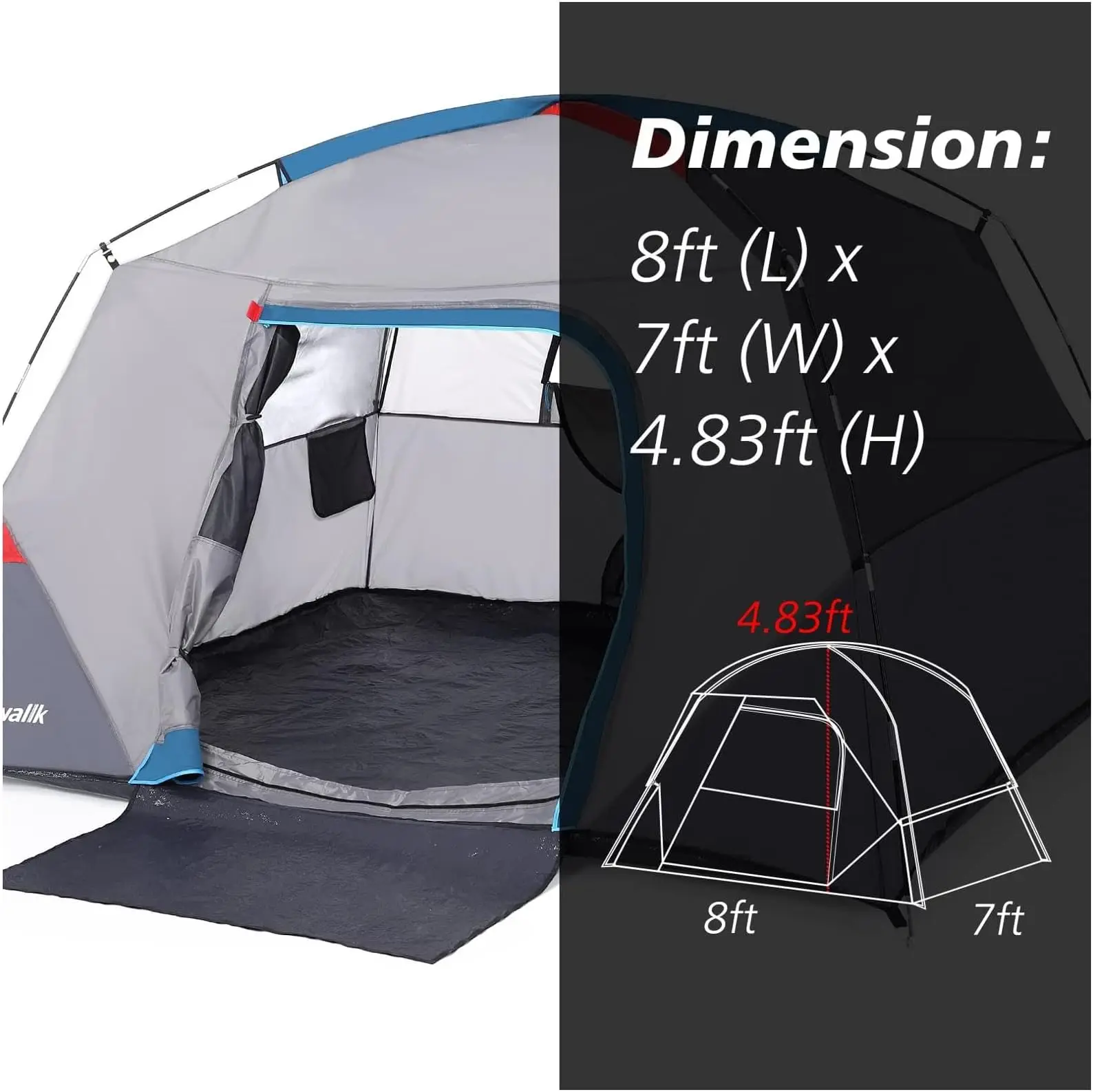
Common Floor Plan Configurations:
Side-by-Side Arrangement – Equal compartments with a central divider, typically with doors on opposite sides. This layout provides similar spaces for two couples or defined sleeping/living zones.
Front-Back Configuration – Often features a smaller rear sleeping area and larger front living space. Ideal for couples wanting separate sleeping and gear organization areas.
L-Shaped Design – Less common but highly effective, creating two rectangular spaces at right angles to each other. Provides more privacy through offset entrances and minimal shared walls.
Hub-and-Spoke Layout – Central communal space with divided “pods” extending outward. Premium designs offering maximum privacy but with more complex setup.
The usable space in each compartment depends not just on floor dimensions but on wall slope and peak height placement. Cabin-style tents with near-vertical walls maximize usable volume compared to dome designs with the same floor area. For comfortable movement and changing clothes, look for compartments with at least 4 feet (1.2m) of height throughout most of the space.
Typical two-compartment tents provide 40-45 square feet (3.7-4.2 square meters) per compartment for 4-person models. For comfortable use, allow at least 20 square feet (1.9 square meters) per person plus additional space for gear storage—more if camping in cold weather with bulkier equipment.
Materials and Construction: Balancing Durability and Weight
The materials used in two-compartment tents significantly impact their performance, durability, and portability. Understanding these differences helps you invest wisely based on your specific camping needs.
Tent Body Materials:
Nylon – Lighter and more compressible but less durable than polyester. Common in backpacking-oriented designs. Typically 40-70 denier thickness for walls.
Polyester – More resistant to UV damage and maintains tension when wet. Standard for family camping tents. Usually 68-75 denier for good durability.
Canvas/Cotton Blends – Heaviest but extremely durable and naturally breathable. Provides excellent insulation and quiet interior. Found in premium “glamping” options.
Mesh Components – Most tents use 40-denier no-see-um mesh for ventilation panels, balancing airflow with insect protection.
Waterproofing Considerations:
Waterproofing is measured by hydrostatic head ratings—the height in millimeters of a water column the fabric can withstand before leaking:
* 1000mm – Basic water resistance (light rain)
* 1500-2000mm – Standard waterproofing (moderate rain)
* 3000mm+ – Excellent protection (heavy, sustained downpours)
Pole Materials and Design:
- Aluminum – Lightweight and durable but more expensive. Standard in quality tents.
- Fiberglass – More affordable but heavier and less resilient in strong winds. Common in budget options.
- Carbon Fiber – Ultra-lightweight but very expensive. Rare except in specialized mountaineering designs.
Floor materials typically use higher denier ratings (often 120-210D) with higher waterproof ratings than the canopy. Look for reinforced corners and stress points where poles connect—these are common failure points in lesser tents.
For those prioritizing durability over absolute minimum weight, canvas camping tent options provide exceptional strength and longevity, though with a size and weight penalty that limits them primarily to car camping scenarios.
Ventilation Systems: Preventing Condensation in Divided Spaces
Proper airflow presents unique challenges in two-compartment tents. Dividers that enhance privacy can restrict air movement, potentially creating condensation issues if not properly addressed through thoughtful ventilation design.
The primary ventilation challenge in divided tents is creating sufficient air exchange without compromising privacy or weather protection. Quality models solve this through:
High/Low Ventilation Pairs – Intake vents positioned low on the tent body with exhaust vents at the ceiling, creating natural convection airflow
Compartment-Specific Controls – Independent vent adjustments for each room, allowing occupants to customize their microclimate
Mesh Divider Options – Interchangeable solid/mesh divider sections to adjust airflow between compartments as needed
Protected External Vents – Rainfly designs that allow vents to remain open during rainfall without water entry
Ceiling Mesh Panels – Large overhead mesh areas (covered by the rainfly) that allow warm, moist air to escape
Proper ventilation becomes especially critical when camping in humid conditions or with multiple occupants. Each person releases approximately one pint of moisture through respiration during sleep, which must exit the tent to prevent condensation.
Signs of inadequate ventilation include morning dampness on the inside of the rainfly, wet sleeping bags (despite no rainfly leaks), and persistent mugginess. Address these issues by opening more vents, creating greater separation between the rainfly and tent body, or reducing the number of occupants if possible.
Campers interested in optimal airflow should explore superior ventilation dome tents which often incorporate design principles that can be evaluated when selecting multi-room options as well.
Special Considerations for Two-Compartment Tents
Setup Complexity: Managing Additional Components
Two-compartment tents inherently involve more components and complexity than their single-room counterparts. This additional sophistication requires thoughtful setup strategies to avoid frustration at the campsite.
The primary setup challenges stem from larger footprints, more poles, and the integration of divider systems. Most quality two-compartment tents mitigate these issues through:
- Color-coded poles and connection points that eliminate guesswork
- Logical setup sequences clearly outlined in instructions
- Hub systems that pre-connect multiple poles at key junctions
- Dividers that attach via simple, intuitive mechanisms
- Unified rainfly designs that deploy in a single piece
Even with these helpful features, first-time setup typically requires 15-25 minutes with two people. This time decreases significantly with practice, often reaching 8-12 minutes for experienced users.
Common setup pitfalls include incorrectly oriented dividers, improperly tensioned rainflies that collect water, and inadequate staking that compromises stability. Always perform a complete test setup at home before your first camping trip to identify any issues in a low-pressure environment.
Packing technique significantly impacts setup ease—roll the tent body with the divider already attached, and store small components in dedicated pouches to prevent loss. Many experienced campers color-code their stake sets to match specific tent sections for faster deployment.
For those prioritizing quick deployment, many easy setup camping tent options incorporate intuitive designs that simplify the process while still providing multiple internal spaces.
Weight and Portability: Transportation Considerations
The additional material required for two-compartment designs inevitably increases weight and packed size—important factors to consider based on your transportation method and distance from parking to campsite.
Typical weight comparisons:
* Standard 4-person single-compartment tent: 10-14 lbs (4.5-6.4 kg)
* 4-person two-compartment tent: 15-20 lbs (6.8-9.1 kg)
* Ultralight backpacking 2-person tent: 3-5 lbs (1.4-2.3 kg)
This weight difference makes most two-compartment models best suited for car camping or sites with short walks from parking areas. However, manufacturers have developed innovative approaches to minimize these penalties:
- Modular designs that can be split between multiple packs
- Hybrid single/double compartment options with removable dividers
- Lightweight materials that sacrifice some durability for significant weight savings
- Streamlined pole structures that reduce framework weight
Packed dimensions typically range from 24-30 inches (61-76 cm) in length with 8-12 inch (20-30 cm) diameters—significantly larger than single-compartment alternatives. Consider your vehicle storage space, especially when packing multiple camping items.
For backpacking applications, look specifically for models advertising “backcountry-friendly” designs with weights under 6 pounds per person and compression sacks that minimize packed volume. These specialized options typically command premium prices but deliver meaningful weight savings.
Optimal Uses for Divided Tent Spaces
The versatility of two-compartment tents allows for creative space utilization beyond simple sleeping arrangements. Understanding these possibilities helps maximize your investment and camping comfort.
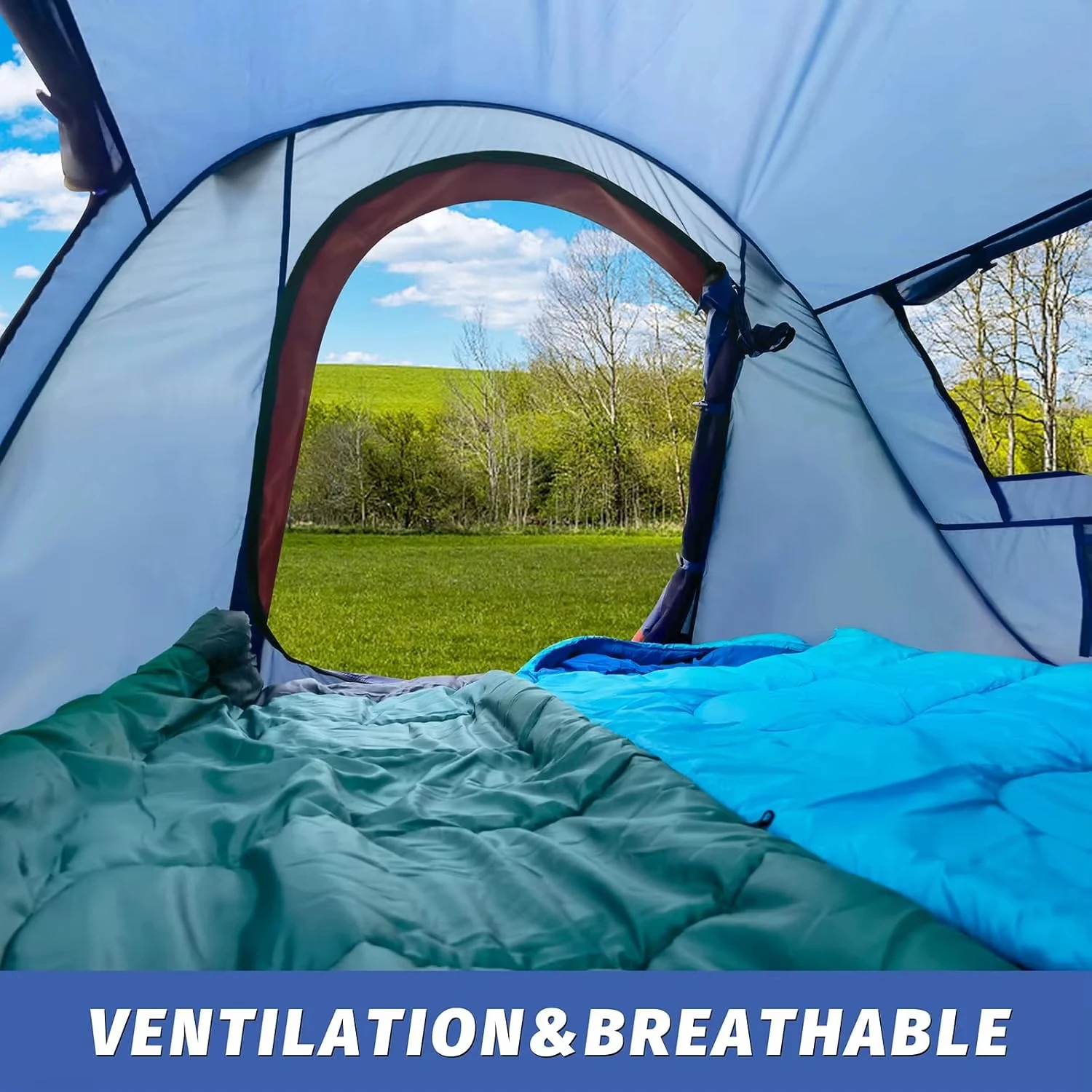
Popular Configuration Approaches:
- Sleep/Live Separation – Dedicated sleeping area remains clean and organized while the second compartment serves as living space with seating and gear
- Adult/Child Zones – Parents maintain privacy while keeping children within easy monitoring distance
- Sleep/Gear Division – One compartment for sleeping with the second housing equipment, clothing, and supplies in an organized manner
- Couples Sharing – Two couples each with private sleeping quarters
- Clean/Dirty Separation – One “clean” compartment for sleeping and changing with a second “dirty” area for muddy gear, wet clothing, and boots
Effective organization systems enhance these arrangements through:
- Hanging organizers on divider walls for small items
- Elevated gear lofts to utilize ceiling space
- Doormat or removable flooring in the “dirty” compartment
- Battery-powered lighting for each zone
- Compression sacks to minimize sleeping gear when not in use
Seasonal considerations also impact optimal usage. In warm weather, the divider might be removed or replaced with mesh to maximize airflow, while colder conditions benefit from complete separation to contain body heat in the sleeping area.
When planning your space, choosing the ultimate compact shelter for two campers provides valuable insights into space efficiency that apply equally to larger divided tents. The principles of thoughtful space allocation remain consistent regardless of tent size.
FAQs About Two-Compartment Tents
Common Questions About Privacy and Functionality
Q: How much privacy do tent dividers really provide?
A: Fabric dividers provide complete visual privacy but limited sound isolation. Conversations at normal volume will be audible between compartments, though whispers typically are not. For maximum privacy, choose models with full-height dividers that attach securely along all edges rather than hanging styles.
Q: Do both compartments stay equally warm?
A: Temperature regulation can differ between compartments based on occupancy, door placement, and sun exposure. Empty compartments typically remain 3-5°F cooler than occupied spaces. Some premium models feature closable vents in the divider to allow or prevent heat transfer as desired.
Q: Can I stand up in both compartments?
A: This depends entirely on the tent design. Cabin-style tents typically offer standing height throughout both compartments, while dome designs may have full height only in the center. Check the peak height specification and wall slope to determine comfortable standing areas.
Q: Will standard air mattresses fit in the compartments?
A: Most two-compartment tents accommodate standard air mattresses, but verify dimensions before purchasing. Queen-sized mattresses (60” × 80” or 152cm × 203cm) typically require at least 65” × 85” (165cm × 216cm) of floor space in the sleeping compartment to fit comfortably with some clearance around the edges.
Q: Can dividers be removed completely for open-plan use?
A: Most quality two-compartment tents allow complete divider removal, converting to a standard single-room tent. Check whether dividers are attached via zippers, toggles, or hook-and-loop fasteners—the attachment method affects how easily they can be removed and reinstalled.
Maintenance and Longevity Questions
Q: How do I clean the divider without damaging it?
A: Most dividers can be spot-cleaned with mild soap and water, avoiding harsh chemicals that might damage waterproof coatings. For stubborn stains, remove the divider (if possible) and hand wash separately, allowing complete drying before reinstallation to prevent mildew.
Q: What parts of two-compartment tents wear out first?
A: Divider attachment points typically experience the most stress, particularly zippers or hook-and-loop fasteners that are frequently adjusted. Floor seams where the divider meets the ground also receive higher wear from foot traffic crossing between compartments. Reinforce these areas with seam sealer during annual maintenance.
Q: How should I store my tent to preserve the divider?
A: Store the tent loosely rolled rather than tightly compressed, with the divider either detached or laid flat without creases. Always ensure the tent is completely dry before storage, as moisture trapped in folded dividers can lead to mildew and fabric degradation.
Making the Right Choice for Your Camping Style
Decision Framework: Matching Tents to Your Needs
Selecting the ideal two-compartment tent requires assessing your specific camping patterns, group composition, and environmental conditions. This systematic approach helps narrow your options to models that truly match your requirements.
Start by answering these fundamental questions:
- Who will be using the tent most often? (Family with children, couples, friends groups, solo camper with gear)
- What’s your primary camping environment? (Forest campgrounds, mountainous terrain, desert, coastal)
- What seasons will you primarily camp in? (Summer only, 3-season, all-season)
- How will you transport the tent? (Car camping exclusively, short hike-in sites, backpacking)
- What’s your priority balance between comfort and portability?
Next, determine your must-have features versus nice-to-have preferences. Must-haves might include minimum standing height, specific waterproofing ratings, or maximum weight limits. Nice-to-have features could include additional doors, specialized storage, or premium materials.
When evaluating options against your budget, consider the frequency of use to determine appropriate investment. Divide the tent cost by your expected days of use over 3-5 years. A $450 tent used for 45 nights costs $10 per night—a reasonable accommodation expense for quality shelter and improved camping experiences.
Remember that tent needs often evolve over time. If you’re new to camping, a versatile model that adapts to different scenarios may serve better than one optimized for specific conditions. Conversely, experienced campers often benefit from purpose-specific tents that excel in their preferred camping style.
Beyond the Tent: Complementary Gear for Two-Compartment Camping
The right accessories enhance the functionality of your two-compartment tent, addressing common challenges and maximizing comfort. Consider these gear additions to optimize your divided tent experience:
Organization Solutions:
* Hanging divider organizers with pockets on both sides
* Freestanding shelving units for the “living” compartment
* Compression storage cubes that stack efficiently in gear areas
* Ceiling-mounted gear lofts that utilize otherwise wasted space
Lighting Optimization:
* Individual headlamps mounted in ceiling loops for each compartment
* Low-intensity perimeter lighting for nighttime navigation
* Dimmable lanterns with directional shades to prevent disturbing tent mates
Privacy Enhancements:
* Sound-dampening blankets for divider reinforcement
* Reflective divider covers to block shadow silhouettes
* Additional floor matting for noise reduction between compartments
Comfort Additions:
* Separate temperature-appropriate sleeping bags for each zone
* Insulated sitting pads for the living area
* Compact folding chairs that store easily between uses
These complementary items need not be expensive—many can be adapted from household items or purchased affordably from outdoor retailers. Focus first on organization systems that keep both compartments functional, then add comfort items as your budget allows.
Expert Tips for Maximizing Your Two-Compartment Tent Experience
After years of testing and using multi-room tents in various conditions, our team has developed these professional insights to help you get the most from your two-compartment shelter:
For efficient setup, designate specific roles rather than both people attempting to do everything. Have one person handle pole assembly while the other manages stake placement and guy lines. This parallel processing approach typically cuts setup time by 30-40% compared to sequential methods.
To optimize privacy between compartments, supplement the divider with strategic gear placement along the divider line. Backpacks or duffel bags positioned against the bottom edge fill gaps and add sound dampening. Hanging a lightweight blanket or towel as a secondary layer also significantly reduces sound transmission.
Weather adaptation requires proactive adjustment. In rainy conditions, create slight depressions in the soil beneath vestibules to prevent water from flowing into the tent. During high winds, reconfigure sleeping arrangements to place the heaviest sleepers on the windward side, providing natural ballast.
Establish clear communication protocols when sharing divided tents. A simple “entering” announcement before unzipping doors prevents startling tent mates. For nighttime bathroom trips, agree on whether low lights are acceptable or if red-light headlamps are required to preserve night vision for others.
Tall / Stand Up Camping Tent, Two Room Camping Tent
$407.93 Select options This product has multiple variants. The options may be chosen on the product pageCompact Backpacking Tent, Lightweight Backpacking Tent, Waterproof Camping Tent
$335.52 Select options This product has multiple variants. The options may be chosen on the product pageCamping Tent with Vestibule, Waterproof Camping Tent
Price range: $407.89 through $479.48 Select options This product has multiple variants. The options may be chosen on the product page- $476.52 Select options This product has multiple variants. The options may be chosen on the product page
- $1,221.93 Select options This product has multiple variants. The options may be chosen on the product page
Backpacking Tent with Vestibule, Trekking Pole Backpacking Tent, Waterproof Camping Tent
Price range: $271.99 through $519.52 Select options This product has multiple variants. The options may be chosen on the product page
Create dedicated zones within each compartment for specific functions. Even in smaller spaces, having designated areas for changing clothes, storing personal items, and sleeping creates psychological comfort and physical organization. Use different colored stuff sacks or organizers to visually reinforce these zones.
Finally, practice adaptability with your tent configuration. The optimal arrangement for summer camping might differ dramatically from spring or fall setups. Experiment with divider positions, door configurations, and ventilation settings to discover what works best in different conditions rather than using a one-size-fits-all approach.
By thoughtfully selecting and optimizing your two-compartment tent, you’ll create a versatile outdoor living space that enhances privacy while maintaining the connection to nature and companionship that makes camping so rewarding.

